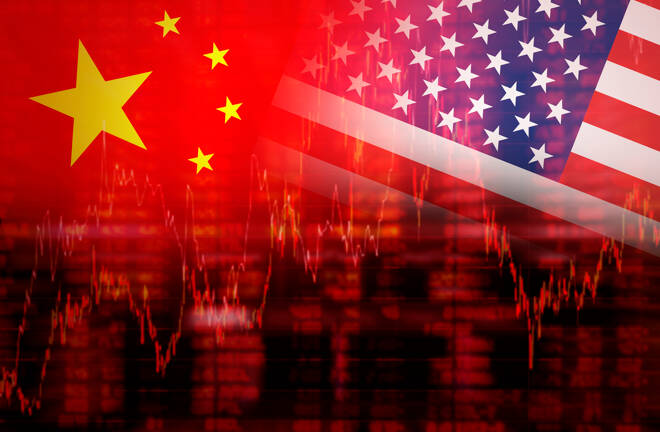Advertisement
Advertisement
US-China Tariff Pause Offers Hope, but Trade Deal Still Faces Tough Road
By:
Key Points:
- Beijing lifts export bans and eases restrictions on US firms despite new US warning on Huawei AI chips.
- Deflation, weak credit demand, and PMI job losses underscore the urgency of China’s stimulus measures.
- US budget deficit could swell $1.3T if a 2025 recession hits, even after $568B in rate-driven savings.
US and China Trade War: China Makes Post-Truce Moves
The US and China hit pause on the ongoing trade war on Monday, May 12, slashing tariffs to buy time for more meaningful trade negotiations. China dropped tariffs on US goods from 125% to 10%, while the US lowered levies on Chinese goods from 145% to 30%. However, the lower tariff rates are only effective for 90 days, meaning both sides must make swift progress to avoid reverting to pre-truce tariffs on Liberation Day (April 2).
Robin Brooks, Senior Fellow at the Brookings Institution, addressed ongoing confusion about current tariff levels, explaining:
“Lots of confusion on what US tariffs on China are now. Key point: the two 10% tariff hikes for fentanyl and the 10% universal tariff hike “stack” on top of tariffs from 2018. Factoring in various exclusions, the tariff rate is near 50%.”
Despite the cut, tariffs remain far above levels seen during Trump’s first term and as of February 2025. Nevertheless, several key developments suggest a willingness to strike a deal. Since Monday’s announcement, Beijing has loosened controls by:
- Pausing export controls on 28 US entities for 90 days.
- Granting export permits to at least four Chinese rare earth magnet suppliers.
- Removing the ban on Boeing deliveries.
Despite the truce, the US issued a global warning against using Huawei AI chips, signaling a tougher stance on tech.
US Recession Risks and China’s Demand Woes
Mounting tariff pressures on both economies may shift Washington and Beijing’s approach. Recent economic data from China revealed the effects of US tariffs, potentially pushing Beijing toward de-escalation.
Deflationary pressures persisted in April, while private sector PMI data showed further job losses, signaling weaker demand.
Alicia Garcia Herrero, Natixis Asia Pacific Economist, remarked:
“While China has clearly outsmarted the Trump administration, reaching a very beneficial deal, the Chinese economy is not doing well. Deflation is in full swing (-0.1% for April CPI and much lower for producer/export prices), and we just got very weak loan/total social financing data. The huge uncertainty is having a toll on the demand for credit and, very likely, on investment.”
New Yuan loans rose by CNY280 billion in April, down sharply from CNY3,640 billion in March, well below an expected CNY700 billion. Weak credit demand could undercut Beijing’s stimulus efforts and weaken consumption if labor market conditions worsen further.
In the US, fears of a recession are also raising alarms about fiscal sustainability. The Kobeissi Letter wrote:
“The US government cannot afford a recession. In previous economic cycles, the US budget deficit widened by ~4% of GDP on average during recessions. This would imply a ~$1.3 trillion deterioration of US government finances if a recession hits in 2025. That said, if the US enters a recession, long-term interest rates will likely go down. A 2-percentage-point decrease in interest rates would save ~$568 billion in annual interest payments.”
The note concluded:
“However, this means government finances would worsen by more than DOUBLE the amount saved in interest due to a recession. An economic downturn would be incredibly costly for the US government.”
Investor Caution Weighs on Asian Markets
While investors initially celebrated the trade truce, doubts remain over whether a lasting trade agreement is achievable.
The CSI 300 fell 0.58% on May 15 while the Hang Seng Index slipped by 0.17% in early trading, holding below the crucial 24,000 mark.
In contrast, the Nasdaq Composite rose 0.72% on May 14, narrowing its YTD gap with the CSI 300. The CSI 300 is now down 0.41% year-to-date (YTD), while the Nasdaq has lost 0.85%. The Hang Seng Index continues to lead with a 17.5% gain YTD.
Outlook
Trade negotiations are likely to remain the key driver of market sentiment. Renewed tensions could stoke US recession fears and prompt another flight to safe-haven assets. However, China’s stimulus policies and the Fed’s monetary stance will also influence risk appetite. A hawkish Fed and weak policy support from Beijing could unsettle markets, while coordinated efforts may help ease volatility.
Stay with us for updates on China’s economic outlook, trade developments, and global market reactions.
About the Author
Bob Masonauthor
With over 28 years of experience in the financial industry, Bob has worked with various global rating agencies and multinational banks. Currently he is covering currencies, commodities, alternative asset classes and global equities, focusing mostly on European and Asian markets.
Advertisement
